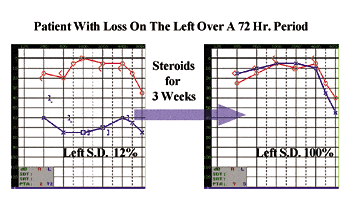People under age 50 with hearing loss misuse prescription opioids at twice the rate of their hearing peers, and are also more likely to misuse alcohol and other drugs, a new national study finds.
This means that health care providers may need to take special care when treating pain and mental health conditions in deaf and hard-of-hearing young adults, the researchers say.
Writing in the April issue of the American Journal of Preventive Medicine, a team from the University of Michigan and VA Ann Arbor Healthcare System describe their findings from data on 86,186 adults who took part in the National Survey on Drug Use and Health. The results were summarized by Michigan Medicine, and appear in an article on the Science Daily website.
In all, adults under 50 with hearing loss were more likely than others in their age group to have a substance use disorder of any kind, while those over 50 with hearing loss did not differ from their peers in rates of substance issues.
Even after the researchers adjusted for differences in social, economic, and mental health between the hearing and hard-of-hearing populations, the differences remained. Adults under age 35 with a hearing loss were two and a half times more likely to have a prescription opioid use disorder.
Those between age 35 and 49 who had hearing loss were nearly twice as likely as their hearing peers to have disorders related to both prescription opioids and alcohol.
Michael McKee, MD, MPH, led the research effort after noticing that that a disproportionate share of his younger patients with hearing loss were struggling with substance use disorders.
McKee runs the Deaf Health Clinic that provides primary care and mental health care to deaf and hard-of-hearing patients of Michigan Medicine, U-M’s academic medical center.
“Hearing loss is connected with a variety of health problems, including mental and physical health, that may place these individuals at risk for pain disorders,” says McKee. “Also, the marginalizing effects of hearing loss, such as social isolation, may be creating higher rates of substance use disorders too.”
For those whose healthcare providers know of their hearing loss, McKee suspects that the higher rate of prescription opioid use disorder may stem from a higher rate of being placed on controlled substances to quickly address pain issues, perhaps because of communication barriers.
“It may be easier to write a prescription rather than engage in complex patient-provider communication between a hearing provider and non-hearing patient,” he says.
But the research suggests that part of the issue may be lack of awareness by health care providers of their younger patients’ degree of hearing loss.
In all, 5% of adults of all ages taking part in the survey said they had serious hearing loss or were deaf. The proportion ranged from 1.5% of those under age 35, to 2.2% of those between 35 and 49, to 9.4% of those over 50.
McKee, a U-M Department of Family Medicine physician who uses a cochlear implant to offset his own hearing loss, says health care providers may be more attuned to potential communication and prescription concerns with older patients. This would mean they would be more likely to avoid many of the prescription use disorders seen in the other two age categories.
“We need to first inquire and ensure effective and accessible communication with our patients. We need to be willing to engage in a dialogue to explore the root of their pain/mental health issues rather than just dispensing a prescription that may lead to dependency or addiction,” he says.
This means providers should use “universal communication precautions—approaching each patient without assumptions about their communication abilities, assessing for hearing loss and other communication-related issues, and determining how to accommodate each patient.
McKee also notes that lack of access to addiction-related care for deaf and hard-of-hearing patients may play a role.
Original Paper: McKee MM, Meade MA, Zazove P, Stewart HJ, Jannausch ML, Ilgen MA. The relationship between hearing loss and substance use disorders among adults in the US. American Journal of Preventative Medicine. 2019;56(4):586-590.
Source: Michigan Medicine, Science Daily, American Journal of Preventative Medicine






Thanks!